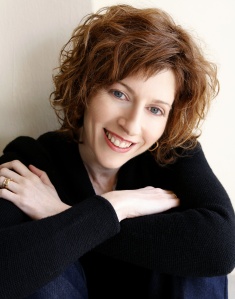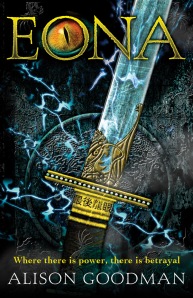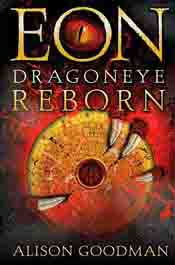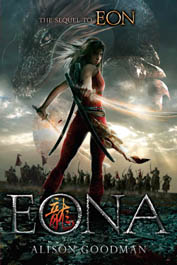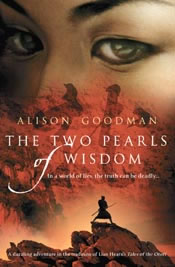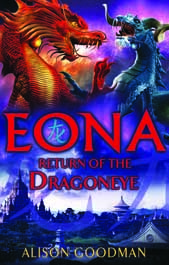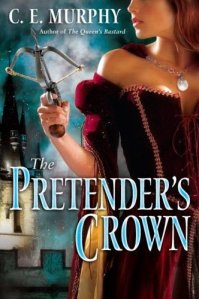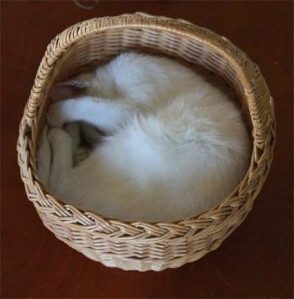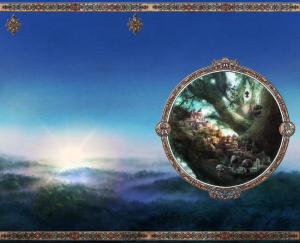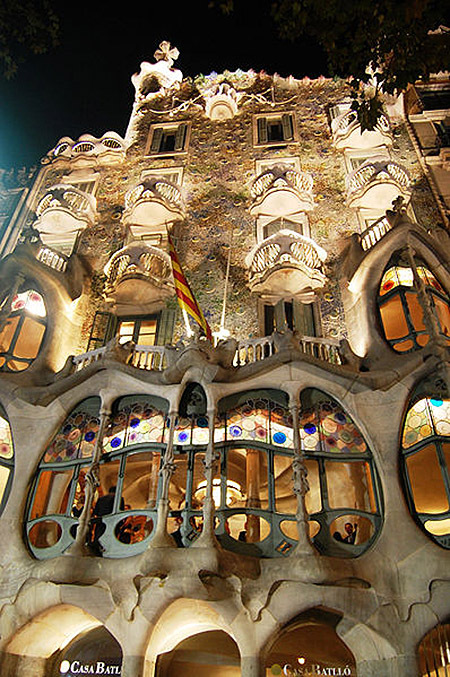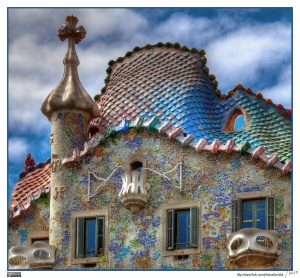As the next of my series featuring fantastic female fantasy authors (see disclaimer) I’ve invited the prolific and talented Trudi Canavan to drop by.
Watch out for the give-away question at the end of the interview. (NOTE this competition is now closed. Thanks for all the entries!)
Q: Like me, you have a background as an illustrator. Do you miss illustrating?
I have to admit, I don’t miss being a freelance illustrator much at all! While it was a fun job to have and I like being self-employed, it didn’t pay very well. Painting and other forms of art are now a hobby again, and it’s much more creatively satisfying to be portraying what I want to portray, in whatever medium inspires me and with no deadlines.
Q: In 1999 your short story Whispers of the Mist Children won the Aurealis Award for Best fantasy Short Story. Are you still writing short stories, or do you find your stories keep growing until they become novels?
Yes, I do still write shorts, though not often. My second published short, “Room For Improvement”, won a Ditmar in 2004 and I’ve had stories published in Dreaming Again and Legends of Australian Fantasy, but that’s four stories over ten years so you can see I’m not all that prolific!
My story ideas come with a length already obvious to me right from the start. I know if there’s ‘enough’ story to fill a short, novella, novel or series. Sometimes there’s a piece of history or character background within a longer work that can be separated out and written in a shorter form, like a short story or novella – like ‘The Mad Apprentice’ novella in the Legends anthology, which is a piece of history from the Black Magician Trilogy world.
Recently I joined a local short story critique group with the aim of both ‘giving back’ to the sff community, polishing my writing and critiquing skills, and motivating myself to write more short stories. I’m hoping to write a few set in the universe of my next series and then, in a couple of years, include them with my old short stories to form an anthology.
Q: In 2001 the first book of your The Black Magician Trilogy series came out. The Magicians’ Guild, The Novice, and The High Lord went on to be best sellers. Was this a bit of a surprise? (A welcome surprise, LOL).
Well, of course! I don’t think any sane writer expects success. They hope for it, and delude themselves that it will happen in order to keep going when times are tough, but they never take it for granted that it’s going to happen.
My dream, which formed when I was about fourteen, was to write a fantasy novel. Having it find a publisher was not necessarily part of the dream, but by the time I’d written it I certainly wanted it to be to justify all the hard work. If I’d not found a publisher I’d have been disappointed, but at least I’d done what I’d set out to do. Everything else has been a bonus. A confidence-boosting bonus and one that’s financially sustainable, thankfully!
 Q: Your second trilogy, Age of the Five has also been a best seller.
Q: Your second trilogy, Age of the Five has also been a best seller.
Yes, though it’s success is overshadowed by the Black Magician Trilogy and its prequel and sequel. Part of that is due to it being aimed at an older market. I decided to do so because I was a little worried I’d be typecast as a YA writer, which isn’t a bad thing for sales but I could see it might be for me as a writer in the long term. I don’t want to be restricted to only being able to publish to one kind of audience.
To make it a non-YA book, I simply had to make the main character older (she’s about 25) and add a few sex scenes. I considered whether upping the violence would make a difference, and realised it probably wouldn’t. You’d have to add very gratuitous violence to a book to make it unsuitable to young people these days!
 Q: Then, in 2007, you signed a ‘seven-figure deal’ with Orbit to write the prequel and sequel to The Black Magician Trilogy. Does this mean that you are one of the mythical writers who doesn’t have to hold down another job to make ends meet while you write? Has this given you freedom and confidence to concentrate on your writing?
Q: Then, in 2007, you signed a ‘seven-figure deal’ with Orbit to write the prequel and sequel to The Black Magician Trilogy. Does this mean that you are one of the mythical writers who doesn’t have to hold down another job to make ends meet while you write? Has this given you freedom and confidence to concentrate on your writing?
The answer to that is yes, but naturally it’s more complicated than that. I started writing as my only source of income before it paid well enough, because I had no choice.
You see, I started my illustration business so I could afford to write part time. A few years after my first publishing contracts I developed chronic fatigue. It wasn’t as debilitating as most cases, but I had to save all my energy for writing, and let the illustration business go. Those early advances didn’t come close to a full time wage and I survived, financially, by been very, very, very frugal.
Thankfully, in the years since then I have regained most of my old energy and the writing brings in a much better income. I’d glad I don’t have to take on a second job, because I worry that doing so would bring back the chronic fatigue. There are other things I’d like to do, like finally get a university qualification, but again, I worry about what affect that would have.
Q: With such a large range of trilogies many of which interrelate do you have a huge whiteboard in your office with timelines, family trees and maps? How do you keep it all straight?
I have a pinboard above my writing desk, but it’s mainly covered in maps and plans. All my lists of made-up words and character names are on my computer. There’s less of this than you’d expect, actually. I try to keep my cast of main characters small enough to be easily manageable. I figure that if I can remember who is who, the chances are better that the average reader will keep track as well.
Q: I know you do a lot of craft, as well as cooking. Do you find that you need these creative outlets to counter balance the intensity of writing really long fantasy trilogies?
Yes, I’ve always found that the compulsion to write dries up if I’m not doing other creative activities. Part of the reason is that I do a lot of thinking about stories when painting or I’m involved in something repetitive and soothing like weaving. Another part is that finishing a craft projects provides a feeling of completion and achievement on a regular basis, which I only get once a year or so from writing. The crafts I do also qualify as research – they provide an understanding of how thing were made in the past and can be a source of inspiration for stories and building fantasy worlds.
I’ve read articles about chemicals in the brain that relate to creativity, that suggest that the more you produce them the easier it is to produce them. Creativity stimulates creativity.
 Q: I was prompted to start this series of interviews because there seems to be a perception in the US and the UK that fantasy is a bit of a boy’s club.
Q: I was prompted to start this series of interviews because there seems to be a perception in the US and the UK that fantasy is a bit of a boy’s club.
When I saw the discussion about this on the internet my first reaction was ‘is there really?’. It’s certainly not the case here in Australia, where most fantasy authors are female.
When I considered the ratio of male to female overseas authors I knew of, there didn’t seem to be a big imbalance. Then I learned that I would be attending a Mega Signing in the UK as part of the publicity tour for The Rogue in May, and that I was the lone woman in a pack of eight male writers. That certainly made me sit up and take notice!
While the boy’s club label didn’t seem immediately true of authors, it did agree with my impressions of the commentators of sff overseas and this article confirmed it. I’ve always been a bit bemused by the UK/US awards shortlists and the books reviewed in magazines. The sort of fantasy they seem to like is what I’d call ‘blokey’.
Q: So you think there’s a difference in the way males and females write fantasy?
Yes, but not all writers all the time. Most male and female writers come pretty close to a style and flavour of fantasy that sits easily in the middle. But there are definitely writers who write in a blokey or feminine style, even if they’re of the opposite gender.
I suspect there are cultural differences, too. The sort of fantasy popular in the US may seem blokey to our Australian tastes because we have more female fantasy writers here and the subtle differences in the way women write fantasy may feel ‘normal’ to us. Is the opposite true? I don’t know. But if it is, it doesn’t seem to be putting off overseas readers. Every time I talk to people in the oversees publishing, bookselling and commentary industries they ask “why are there so many fantastic women fantasy writers in Australia?”. Maybe the question should be “why aren’t we paying more attention to all the fantastic women fantasy writers in your own country?”.
Q: Following on from that, does the gender of the writer change your expectations when you pick up their book?
I would be lying if I said it didn’t, but the important thing is it doesn’t stop me wanting to read a book. Ultimately I want to read a good book, and I never consider if that’s more likely because the writer is male or female. I certainly never decide that a book is bad or not my taste because of the gender of the writer.
I know some readers do, and I slot that in the same category of “extremely fussy and a bit strange” readers along with those who won’t read a book written in first person, or that have prologues or epilogues, or with a point of view character in a gender or sexual orientation different to their own.
I don’t feel I should be judgemental toward a reader because of their reading comfort zones, but I do feel sad that they may be missing out on great books.
Q: What do you plan to write next?
I’m really excited about the next series, Millennium’s Rule, which we’ve just finished negotiating the contract for. It is set in a multiple world scenario, where characters with the ability can hop from one world to another. In one world, where there has been a kind of industrial revolution powered by magic, a young archaeology student finds an ancient treasure – a sentient book. In another world, trapped in its own dark ages, the daughter of a cloth merchant must hide her powers from magic-hating, priests.
Q: Sounds like fun to read and to write! And here’s the fun question. If you could book a trip on a time machine, where and when would you go, and why?
I would go into the future, maybe by a hundred years. Maybe that’s surprising from a writer of fantasy, which is mainly set in worlds based on past eras, but I’m not under any delusions that any time in the past was a better one than now. Not that I expect the future is guaranteed to be either, but I always want to know to know what happens next.
To win a copy of Trudi’s latest book ‘The Rogue’ answer this question: Why do you think there are so many fantastic female fantasy writers in Australia?




